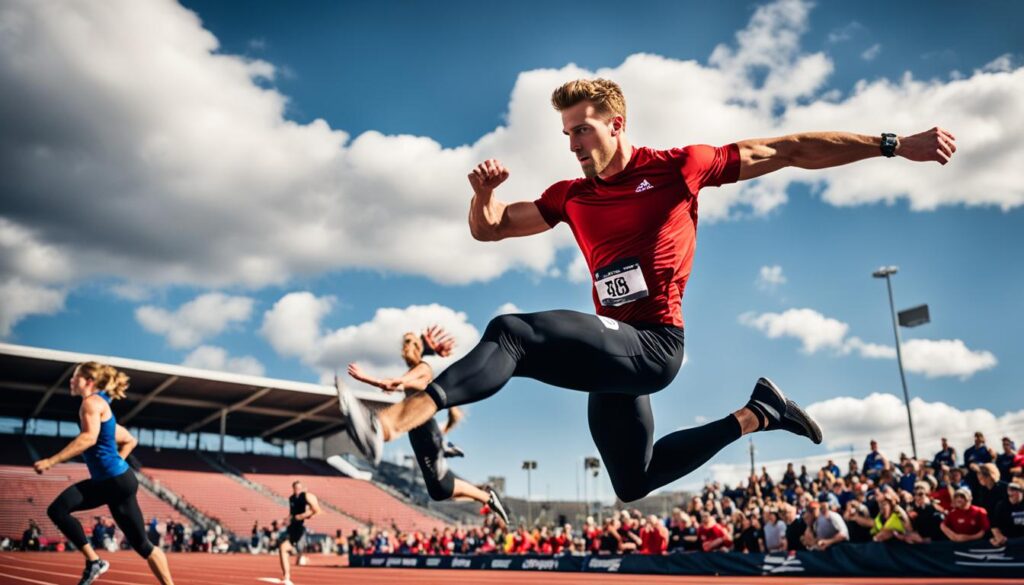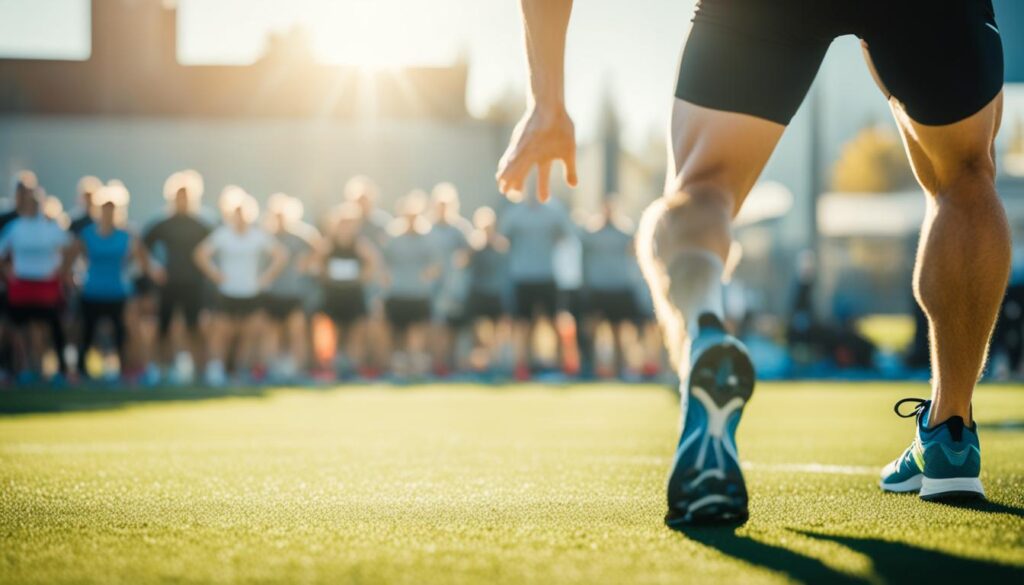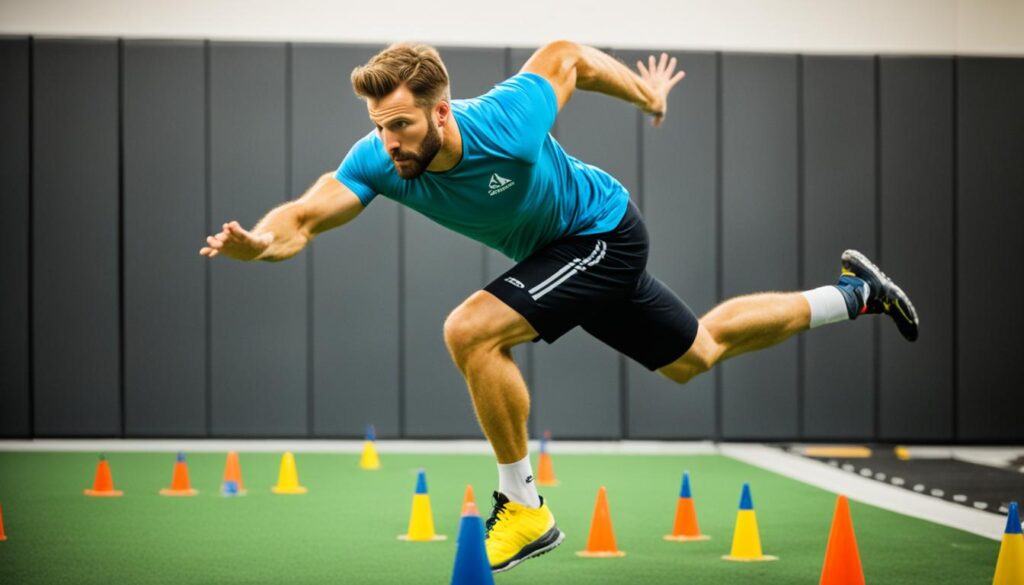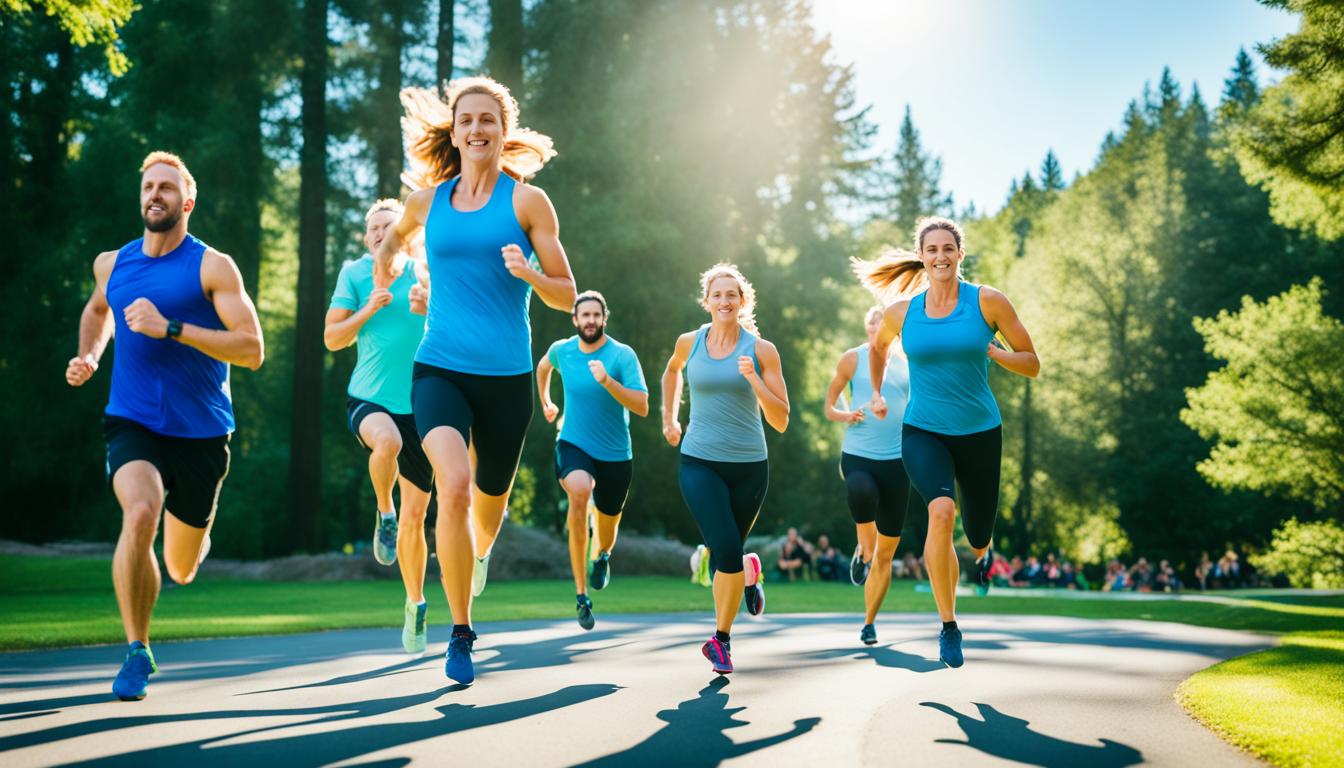Did you know adding 10 minutes of running drills to your workout can make you 15% more efficient? These exercises are vital for beginners and experienced runners alike. They focus on improving cadence, foot strike, and arm swing, speeding up each step.
Running drills do more than get you warm. They are strategic moves to better your running form. These top drills increase your speed and help you last longer by making your form better. Adding these drills into your practice means better running and fewer injuries. They’re perfect for cutting time off your marathon or just running more comfortably.
Key Takeaways
- Running drills can boost efficiency by up to 15%.
- They help improve running cadence, foot strike, and arm swing.
- The best running drills enhance speed and endurance.
- Integrating these drills can prevent injuries.
- Running drills contribute to a better overall running economy.
What Are Running Drills?
Running drills help runners get better at their sport. They focus on improving how you run by teaching good movement. This makes them key for anyone looking to run better.
Understanding the basics of running weight
At their core, running drills copy the real running motion but in a focused way. This trains your muscles to move more effectively. Beginners start with simple drills to get more comfortable and skilled. These drills also work on bettering your running form, like how you step and pace.
Different types of running but the different drills
There are many kinds of running drills, each with its own goal. Form drills, like A-skips, work on improving things like how high you lift your knees and how you swing your arms. Plyometric drills, such as bounding, build muscular strength and power. Warm-up routines often include dynamic stretches to get muscles ready and increase flexibility.
Benefits of Running Drills for Runers
Running drills boost the running experience and performance for every runner. They help build better mechanics, increase muscle strength, prevent injuries, and make running more efficient.
Enhanced Running Mechanics
Running drills focus on repeating good movement to improve speed and technique. This practice turns proper running form into second nature. It enhances efficiency and can be enjoyable.
Improved Muscle Activation
Running drills turn on key muscle groups, focusing on fast-twitch fibers. These fibers help with speed and power. With drills, runners can sprint faster and stronger.
Prevention of Injuries
Running drills also prevent injuries by strengthening muscles and enhancing form. They ensure even stress distribution across the body. This cuts down the risk of injuries common among runners.
Increased Running Economy
Running drills improve how efficiently you run. Better movement patterns mean you use less energy. This lets you run faster and longer, making training both effective and fun.
High Knees: The Ultimate Speed Drill
The high knees drill boosts running speed. It strengthens muscles like hip flexors and glutes. It also improves posture and quickens pace.
How to perform high knees
Start by standing tall. Keep your feet hip-width apart. Bring your right knee up towards your chest.
Keep your back straight as you do this. Then, quickly switch, lifting your left knee. Try to keep the movement fast, landing on your midfoot.
Benefits for hip flexors and glutes
High knees make your hip flexors and glutes strong. These muscles are key for fast running. This drill also makes your running form better.
With stronger hip flexors and glutes, you can run more stably. This can help prevent injuries too.
Integration into workout routines
You can add high knees to your workouts in many ways. They’re great for warming up or as part of a dynamic workout.
Use them to get your muscles moving before a run. Or, do them to work on landing on your midfoot and keeping a quick pace. They help runners at every level.
Walking Lunges for Dynamic Warm-Up
Walking lunges are a key part of dynamic warm-up drills. They get your body ready for the tough work of running. They work your core, glutes, quads, and hamstrings. This makes them perfect for running drills for a warm-up. Adding walking lunges to your warm-up activates these muscles. This improves your overall performance.
To do the walking lunges exercise, start with your feet together. Step forward with one leg. Lower your hips so both knees bend at 90 degrees. Keep your back straight and tighten your core to stay balanced. Then, push off with your front foot to step forward with the other leg. Keep repeating this movement.
Walking lunges in your warm-up boost your flexibility and muscle readiness. This makes moving into harder running drills smoother. They also better your balance and coordination. These are vital for running well and avoiding injuries.
Bounding: Boost Your Power and Stride
Bounding is a dynamic plyometric exercise. It enhances power and increases stride length for runners. By adding bounding drills to your training, you gain a forceful, sustained stride. This is key for athletes wanting more explosive power and better running efficiency.

Steps to Execute Bounding Drills
Start with an exaggerated skipping motion to do bounding. Propel forward with high knee lifts and strong arm swings. Land on your midfoot and aim for vertical lift. Keeping the right form is crucial to avoid injury and ensure the best results.
Benefits for Calf and Glute Strength
Bounding boosts calf and glute muscles. Driving up and forward works these muscles hard. This builds endurance and power. With regular bounding, you’ll see your stride lengthen and efficiency improve. Make it part of your routine for faster times and better economy in running.
To understand bounding drills better, see the details below:
| Component | Details |
|---|---|
| Exercise Type | Plyometric |
| Target Muscles | Calves, Glutes |
| Key Benefits | Improved Power, Extended Stride |
| Execution Tips | High Knee Lift, Midfoot Landing, Vertical Propulsion |
Incorporating bounding into your workouts builds necessary muscle strength. It empowers a superior running stride. This enhances your overall athletic performance.
Butt Kicks: Enhance Your Quadriceps Strength
Butt kicks are a key drill for runners that boost hamstring flexibility and make the quadriceps stronger. When you do butt kicks correctly, you quickly take small steps. Your heels should touch your buttocks. This helps with fast turnover, which is vital for speeding up. This active exercise also serves as a great warm-up. It helps increase your overall stride rate which is linked to better speed.

Adding butt kick drills to your running routine can improve your kick phase. This leads to better running performance. Regularly doing these quadriceps exercises builds muscle memory and betters your running posture. The trick is to keep a steady pace and use the right muscles to get the most out of the drills.
Butt kick drills, when done often, help with speed by making your running gait more efficient. This drill not only makes your quadriceps stronger but also helps your legs and upper body work better together while running. This is crucial for reaching higher speeds. Next, we compare the main advantages of including butt kicks in your training:·p>
| Aspect | Benefits |
|---|---|
| Hamstring Flexibility | Improves flexibility and lowers injury risk |
| Quadriceps Strength | Boosts quadriceps force, leading to stronger steps |
| Stride Rate | Raises turnover rate, enhancing speed |
| Warm-up Efficiency | Gets muscles ready for tough running sessions |
Adding Carioca to Improve Coordination and Agility
Carioca drills can make a big difference in your running. They improve coordination, agility, and hip flexibility. They’re great for runners.
Technique for Performing Carioca
The carioca or grapevine drill uses sideways movement. Start by standing sideways. Then cross your right foot over your left. Then, step your left foot behind your right. Keep your moves smooth and torso upright. Do the drill in both directions to work muscles equally.

Benefits for Hip Flexibility and Strength
Carioca drills are super for the hips. They make hips more flexible and rotate better. The drills also strengthen hip muscles. This improves stability and balance.
These drills make you more agile and help move easier during runs. They are good for quick turns without losing speed. It’s useful for dodging obstacles or making sharp turns.
Carioca drills aren’t just for hips. They boost overall coordination and agility. This makes running easier and safer. Adding them to your routine can help you run better, whether in a race or just for fun.
Advanced Running Drills for Experienced Runners
Seasoned runners can elevate their game with advanced running drills. These drills boost speed and improve neuromuscular coordination. This results in better race times and more efficiency.
Plyometric Drills for Building Speed
Plyometric drills are top choices for boosting explosive speed. A-skips, B-skips, and straight-leg runs work well. They help increase muscle power and speed endurance by focusing on quick ground force.
Integrating Advanced Drills into Training
Adding these drills into your routine takes careful planning. It’s important to consider your current fitness and goals. Start plyometric drills slowly to prevent injuries.
Do these drills after warming up. They’re best on days focused on speed or strength. Advanced drills not only boost performance but also cut down injury risks. They strengthen muscles and refine running form, crucial for runners aiming higher.
How to Incorporate Running Drills into Your Routine
Adding running drills to your routine can really change your performance. Whether you want small improvements or big advances, drills help with speed, strength, and how you move. It’s important to figure out the best times for these drills, like during warm-ups, the main workout, or cooling down.
Starting with dynamic drills like high knees or butt kicks is great for warm-ups. These exercises get your muscles ready, boost blood flow, and prep your body for a hard run. By kicking off your workout with these drills, you lay a strong foundation. This can lead to better performance and fewer injuries.
Plyometric drills and sprints, on the other hand, are great for the middle of a workout or on their own. These high-energy activities should come when you’re already warmed up. This lets you put in your max effort. Ending your run with strides helps you move from a steady pace to faster speeds more smoothly.
You must balance your drill intensity and recovery time to avoid too much training. Careful planning of your running drills can unlock their benefits. This includes better speed, longer endurance, and a more efficient run. Remember, being consistent and adjusting wisely are key. This strategy will help you get the most out of adding drills to your runs.


1 Comment
Submit a Comment